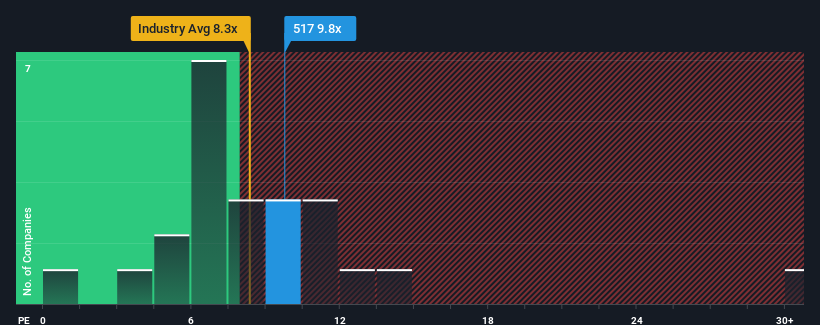
There wouldn't be many who think COSCO SHIPPING International (Hong Kong) Co., Ltd.'s (HKG:517) price-to-earnings (or "P/E") ratio of 9.8x is worth a mention when the median P/E in Hong Kong is similar at about 11x. While this might not raise any eyebrows, if the P/E ratio is not justified investors could be missing out on a potential opportunity or ignoring looming disappointment.
We've discovered 2 warning signs about COSCO SHIPPING International (Hong Kong). View them for free.Earnings have risen firmly for COSCO SHIPPING International (Hong Kong) recently, which is pleasing to see. One possibility is that the P/E is moderate because investors think this respectable earnings growth might not be enough to outperform the broader market in the near future. If that doesn't eventuate, then existing shareholders probably aren't too pessimistic about the future direction of the share price.
View our latest analysis for COSCO SHIPPING International (Hong Kong)

Is There Some Growth For COSCO SHIPPING International (Hong Kong)?
COSCO SHIPPING International (Hong Kong)'s P/E ratio would be typical for a company that's only expected to deliver moderate growth, and importantly, perform in line with the market.
Taking a look back first, we see that the company grew earnings per share by an impressive 20% last year. The latest three year period has also seen an excellent 157% overall rise in EPS, aided by its short-term performance. So we can start by confirming that the company has done a great job of growing earnings over that time.
Weighing that recent medium-term earnings trajectory against the broader market's one-year forecast for expansion of 18% shows it's noticeably more attractive on an annualised basis.
In light of this, it's curious that COSCO SHIPPING International (Hong Kong)'s P/E sits in line with the majority of other companies. It may be that most investors are not convinced the company can maintain its recent growth rates.
The Final Word
Using the price-to-earnings ratio alone to determine if you should sell your stock isn't sensible, however it can be a practical guide to the company's future prospects.
We've established that COSCO SHIPPING International (Hong Kong) currently trades on a lower than expected P/E since its recent three-year growth is higher than the wider market forecast. When we see strong earnings with faster-than-market growth, we assume potential risks are what might be placing pressure on the P/E ratio. It appears some are indeed anticipating earnings instability, because the persistence of these recent medium-term conditions would normally provide a boost to the share price.
We don't want to rain on the parade too much, but we did also find 2 warning signs for COSCO SHIPPING International (Hong Kong) that you need to be mindful of.
If you're unsure about the strength of COSCO SHIPPING International (Hong Kong)'s business, why not explore our interactive list of stocks with solid business fundamentals for some other companies you may have missed.
Have feedback on this article? Concerned about the content? Get in touch with us directly. Alternatively, email editorial-team (at) simplywallst.com.
This article by Simply Wall St is general in nature. We provide commentary based on historical data and analyst forecasts only using an unbiased methodology and our articles are not intended to be financial advice. It does not constitute a recommendation to buy or sell any stock, and does not take account of your objectives, or your financial situation. We aim to bring you long-term focused analysis driven by fundamental data. Note that our analysis may not factor in the latest price-sensitive company announcements or qualitative material. Simply Wall St has no position in any stocks mentioned.